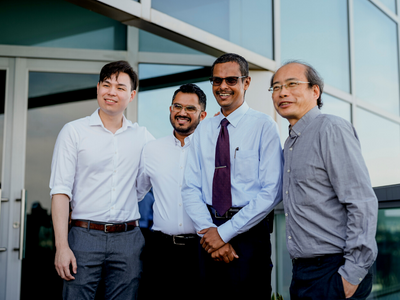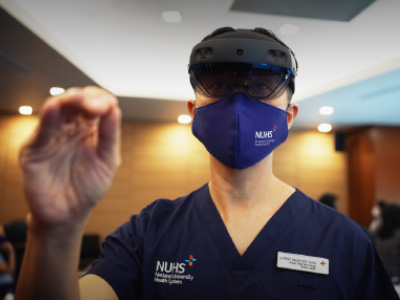Published on 21 April 2024
Chordomas are rare tumours that exert pressure on nearby areas of the spinal cord or brain, potentially causing symptoms such as blurred vision, headaches, or even death.
At first glance, Mr Fazli Nasser looks just like anyone you might come across on the street.
However, it is only when he shifts his gaze sideways that you notice something different about him: his right eye moves, but his left eye remains fixed in place.
Apart from that, there is nothing about the 40-year-old’s appearance or behaviour to indicate that he is, in fact, battling a tumour that could potentially be fatal or result in permanent disability.
Mr Fazli, a freelance content creator and father of three, has been diagnosed with a type of bone cancer known as chordoma.

Chordomas are rare tumours – affecting approximately just one in a million people worldwide – that can occur anywhere within the spine or the base of the skull.
While chordomas are slow-growing and do not spread quickly to other parts of the body, they can cause problems by pressing on the spine, brain, and nerves as it gets bigger.
This can lead to several complications such as headaches, facial paralysis, partial loss of vision, or swallowing difficulties, among other potential issues. If left untreated, chordomas could even become life-threatening.
Asst Prof Vincent Nga, Head & Senior Consultant, Division of Neurosurgery, Department of Surgery, National University Hospital (NUH), elaborated, “Despite advances in surgical and radiotherapeutic techniques, the prognosis for clival chordoma remains guarded.
“Long-term follow-up is essential due to the potential for late recurrences. Multimodal treatment strategies and ongoing research into the molecular biology of chordomas are aimed at improving outcomes for patients with this challenging disease.”
He added that on average, about 70 to 80 per cent of patients survive for at least five years after diagnosis, while only 50 to 60 per cent of patients do not experience cancer growth or spread during this time.
Asst Prof Nga also admitted that the exact causes of chordomas are not “fully understood” yet, but that factors such as genetics, molecular alterations and prior radiation exposure could play a part in the way it develops.
“The rarity of the disease makes it challenging to establish definitive causative relationships,” Asst Prof Nga explained. “Research into the molecular and genetic underpinnings of chordomas continues to evolve, with the aim of improving diagnosis, treatment, and understanding of the disease's cause.”
The first indication that something was amiss for Mr Fazli occurred in 2003, when he discovered he could not move his left eye, and experienced double vision when looking to his left.
After undergoing an MRI, doctors discovered that a small tumour was affecting his left eye. However, they reassured Mr Fazli that the tumour was benign, and his left eye regained its function after six months. Consequently, he decided to stop going for further medical check-ups for the condition.
But in late 2019, Mr Fazli suddenly felt an "electric, stinging sensation" on the left side of his face, which eventually developed into numbness and loss of feeling.

Concerned, he sought medical attention at NUH for further evaluation. There, it was discovered that his symptoms were caused by his tumour, which had by now grown to a significant size.
In June 2020, Mr Fazli underwent surgery at NUH with Asst Prof Nga to remove the tumour located at the base of his skull, specifically at the bone called the clivus. This was done via the nose using a minimally invasive endoscopic approach, which involves using small cameras to see around corners and maximise tumour removal.
While radiation therapy is generally recommended after surgery to prevent any remaining cells from regrowing or spreading to other parts of the body, Mr Fazli opted not to do the procedure then, as there was a risk of optic nerve damage, which could potentially lead to blindness.
However, chordomas often recur after treatment, and three years later, Mr Fazli had to undergo a craniotomy – a procedure to cut and temporarily remove a piece of skull bone to access the brain – to remove more of the tumour that had grown back.
In April this year, Mr Fazli underwent yet another craniotomy surgery to remove more of his tumour. This time, however, some parts of the tumour had calcified, which made the surgery more complex.
“Calcified tumours are slow growing or may have completely stopped growing. In his (Mr Fazli’s) case, part of the tumour has undergone dense calcification, suggesting that part of the tumour may no longer be actively growing,” Asst Prof Nga said.
“Calcification, being hard, makes surgery in these deep and highly sensitive locations of the brain more challenging. Attempts to remove calcified portions that may be attached to the surrounding important nerves and blood vessels may lead to significant injuries to these structures.
“However, it also means that complete removal of the inactivate parts of the tumour is likely unnecessary.”
Following his latest surgery, Mr Fazli has decided to undergo radiation therapy to control the growth of the tumour. The therapy is expected to commence sometime in the middle of this year.
While Mr Fazli still has some way to go on his road to recovery, Asst Prof Nga is hopeful that he will be able to overcome the challenges and achieve a positive outcome.
“Mr Fazli specifically has several factors that are in his favour. The relatively slow-growing nature of his tumour, his young age and the CT scan findings of the tumour being increasingly calcified (less actively growing),” Asst Prof Nga said.
“This is in addition to the availability of the comprehensive suite of advance treatment modalities and expertise in Singapore.”
In consultation with Asst Prof Vincent Nga, Head & Senior Consultant, Division of Neurosurgery, Department of Surgery, NUH, and Senior Consultant, National University Spine Institute, National University Health System.



